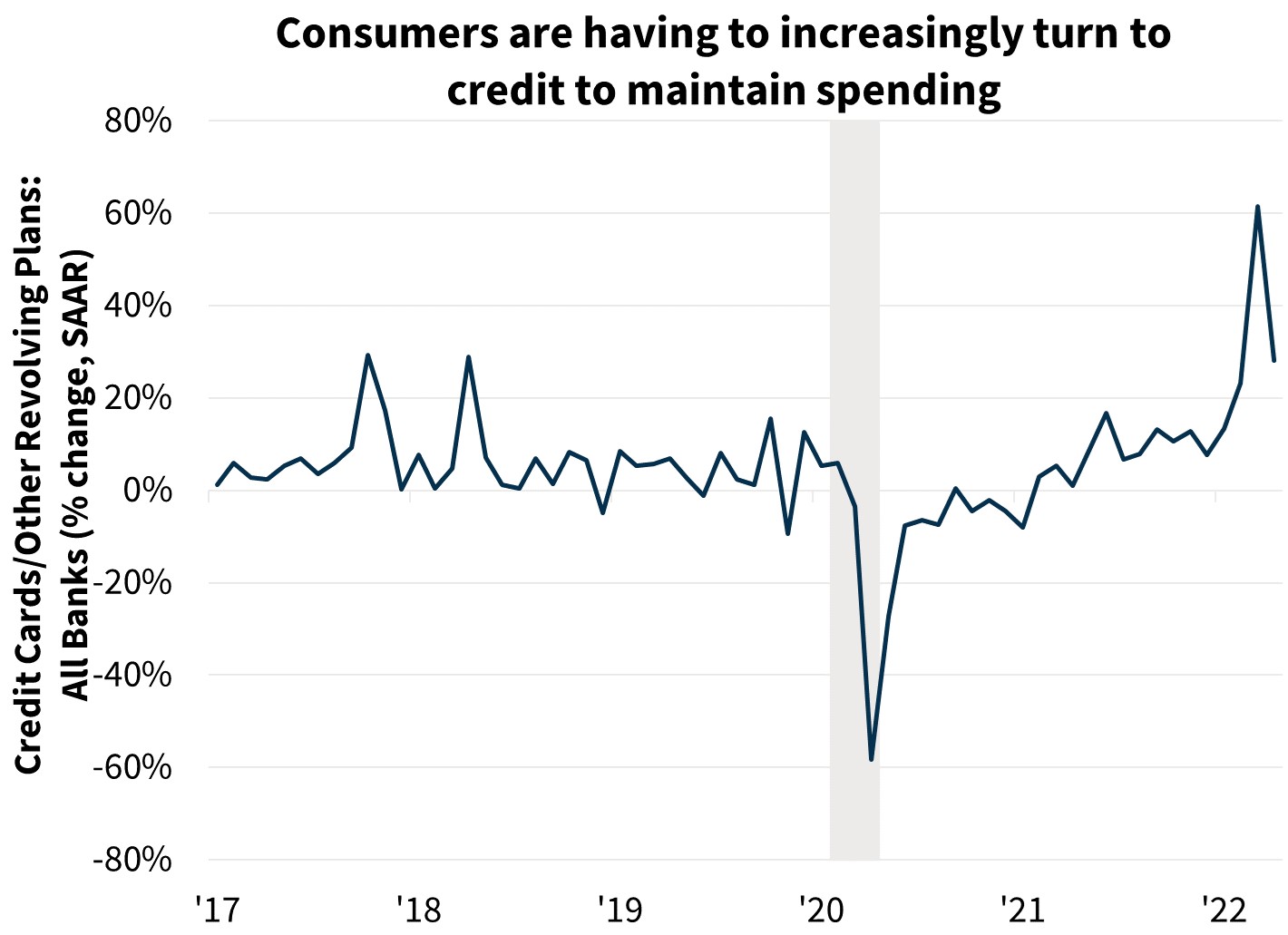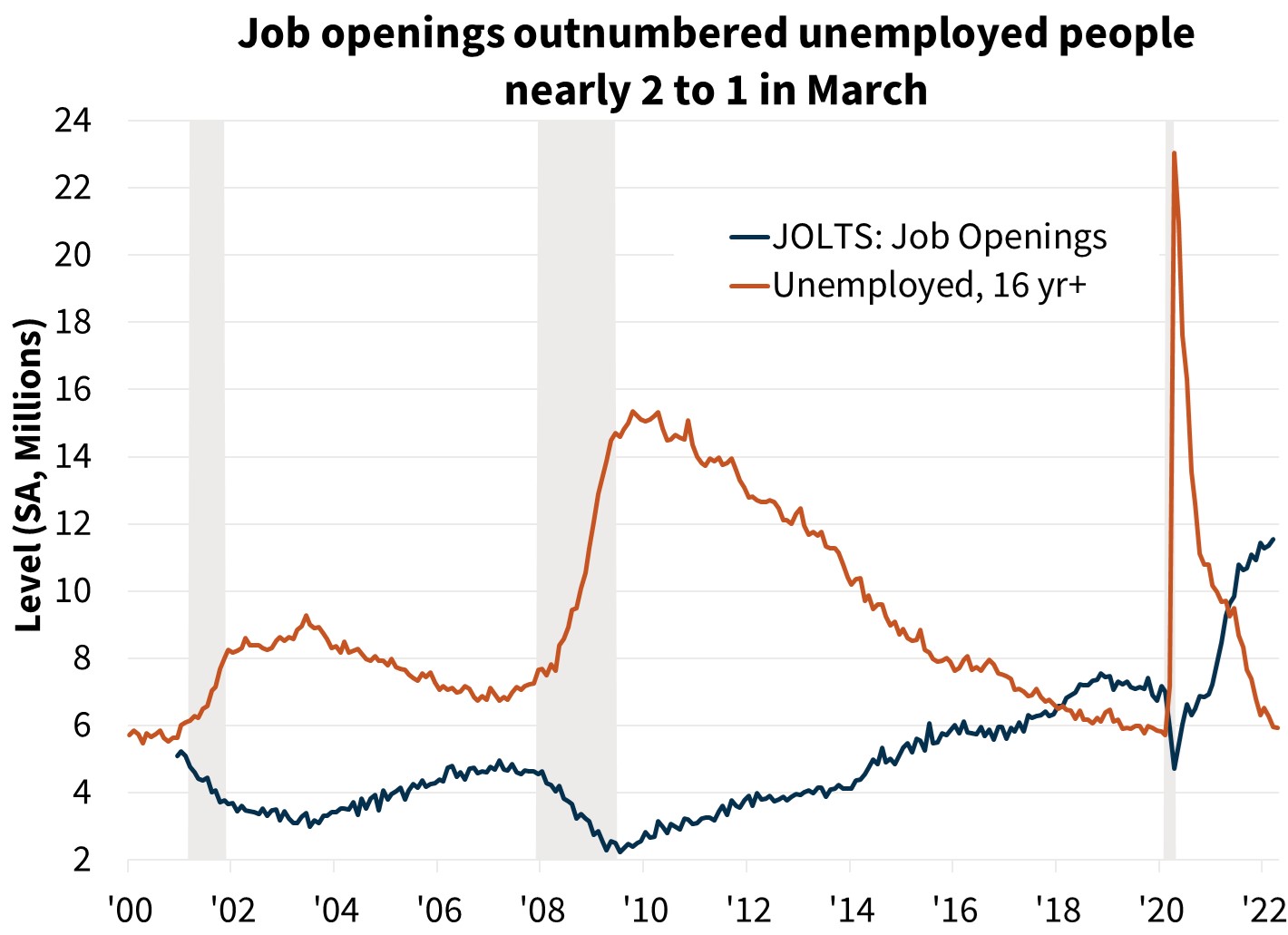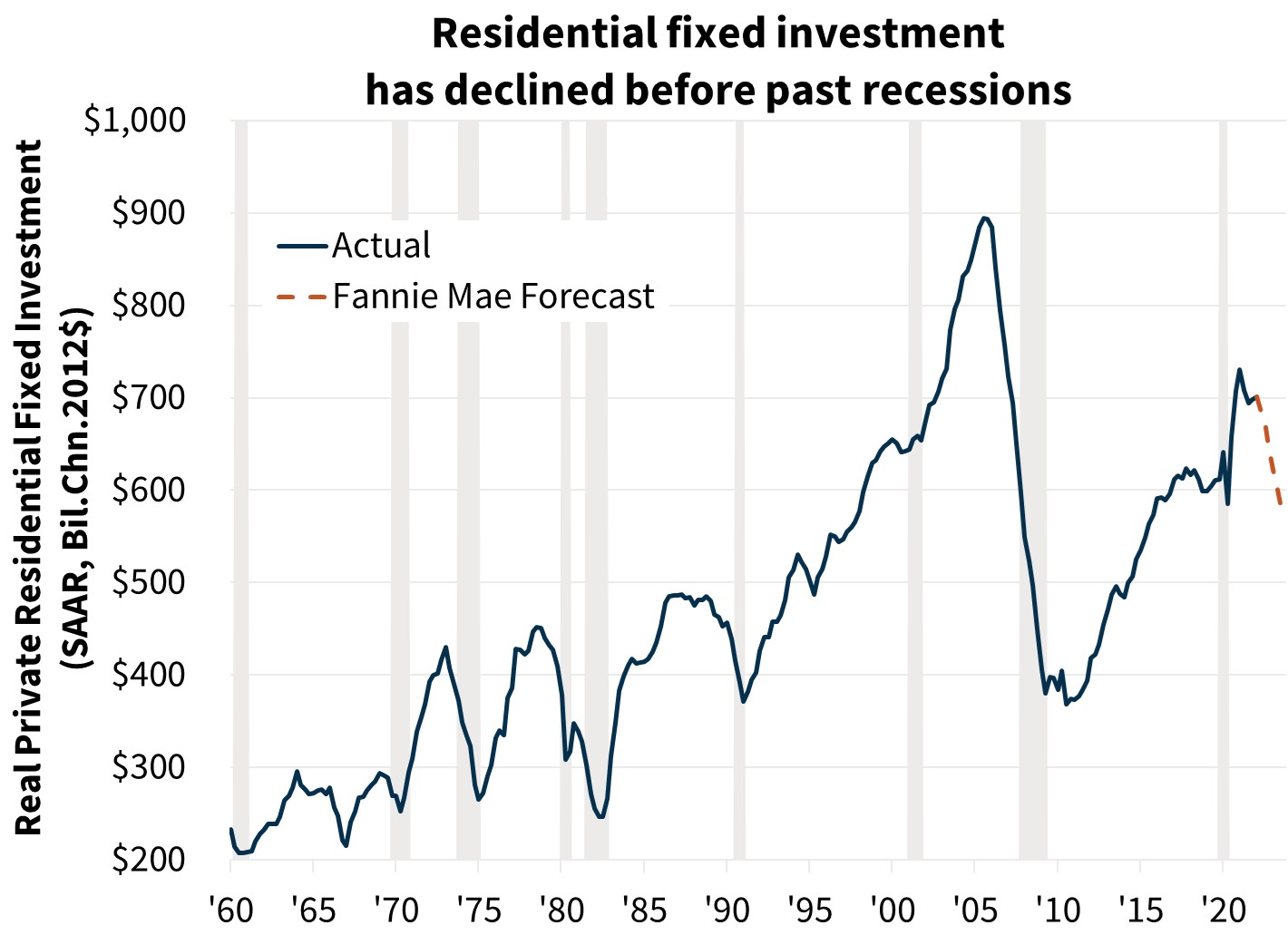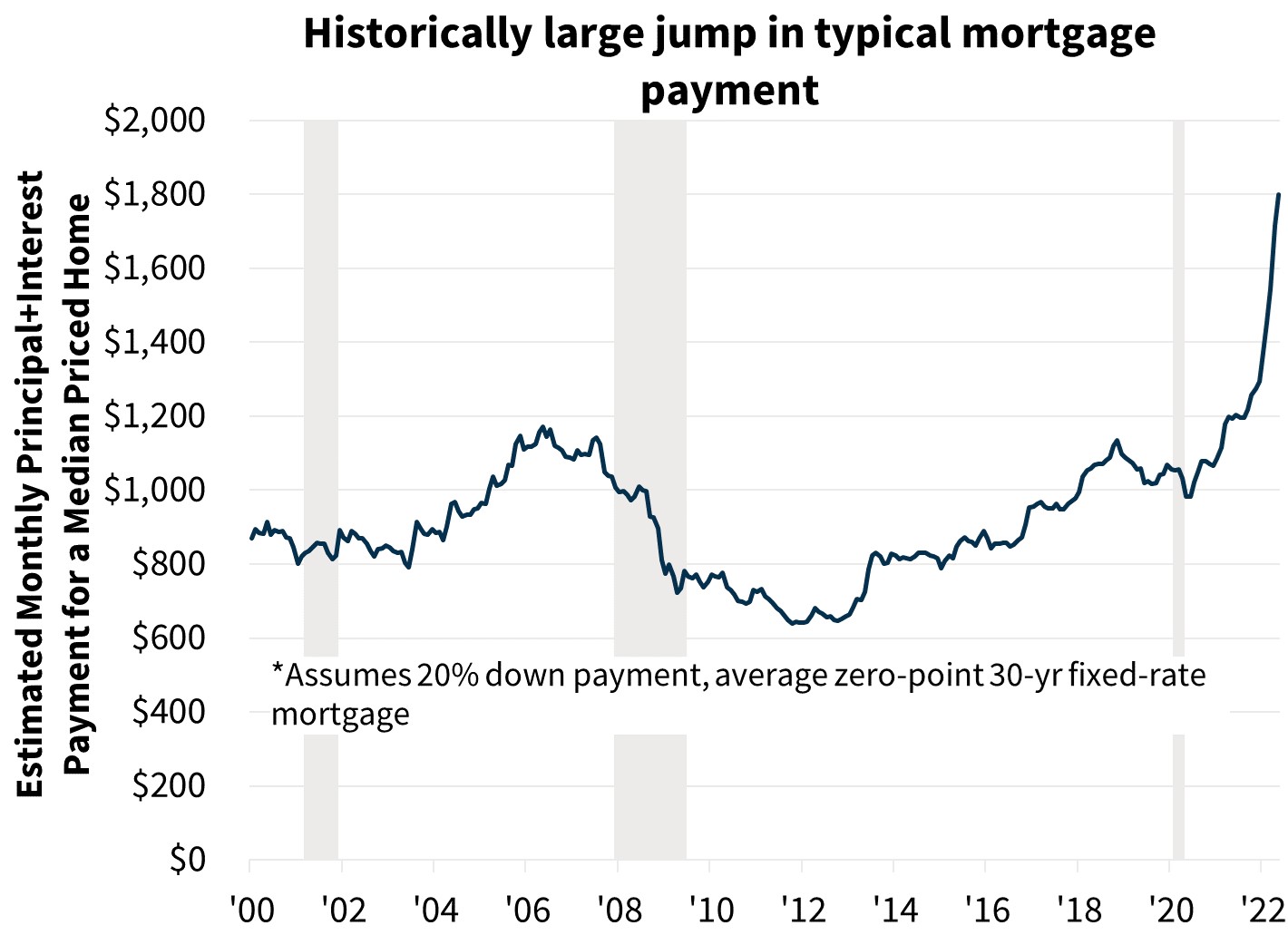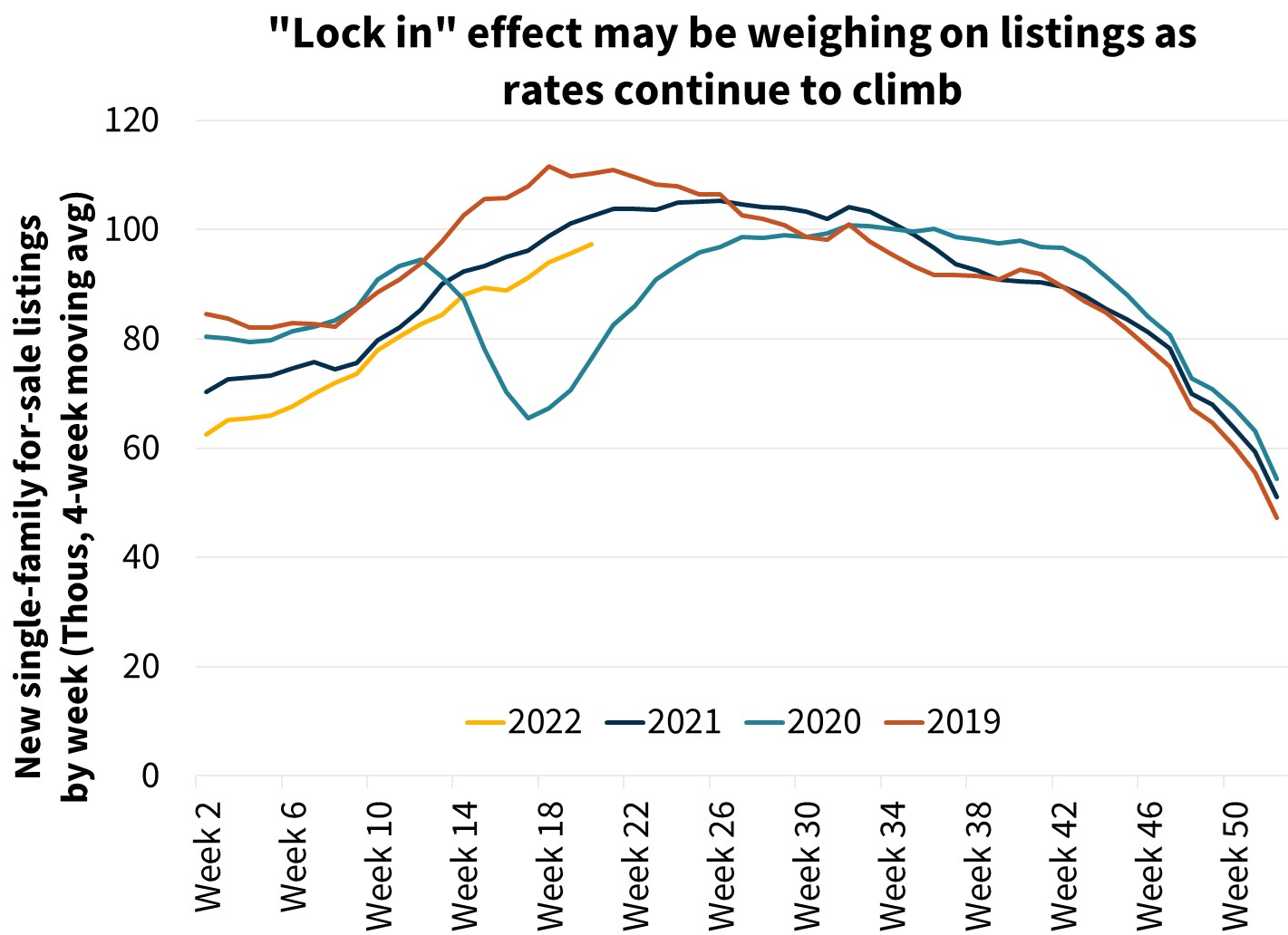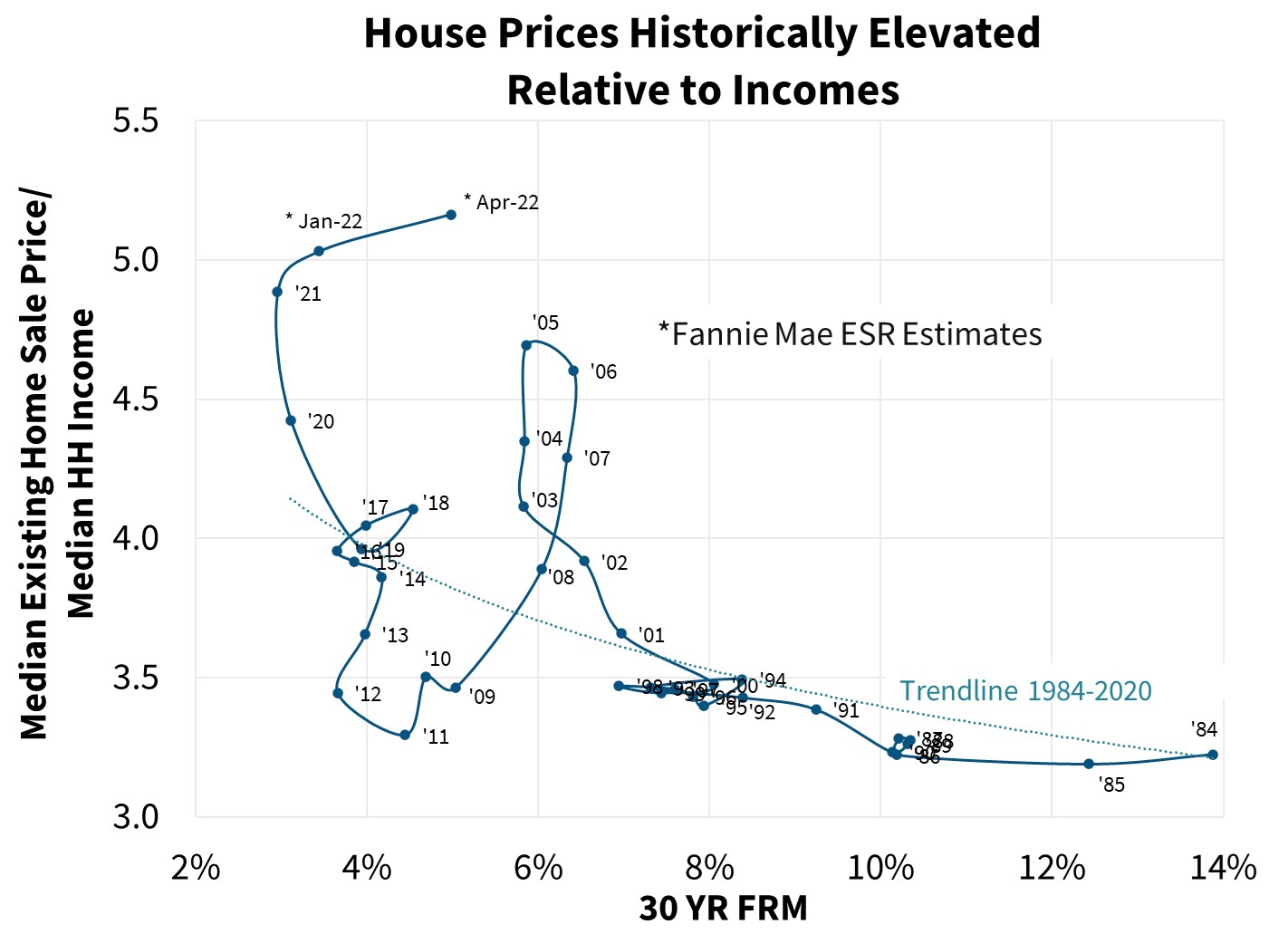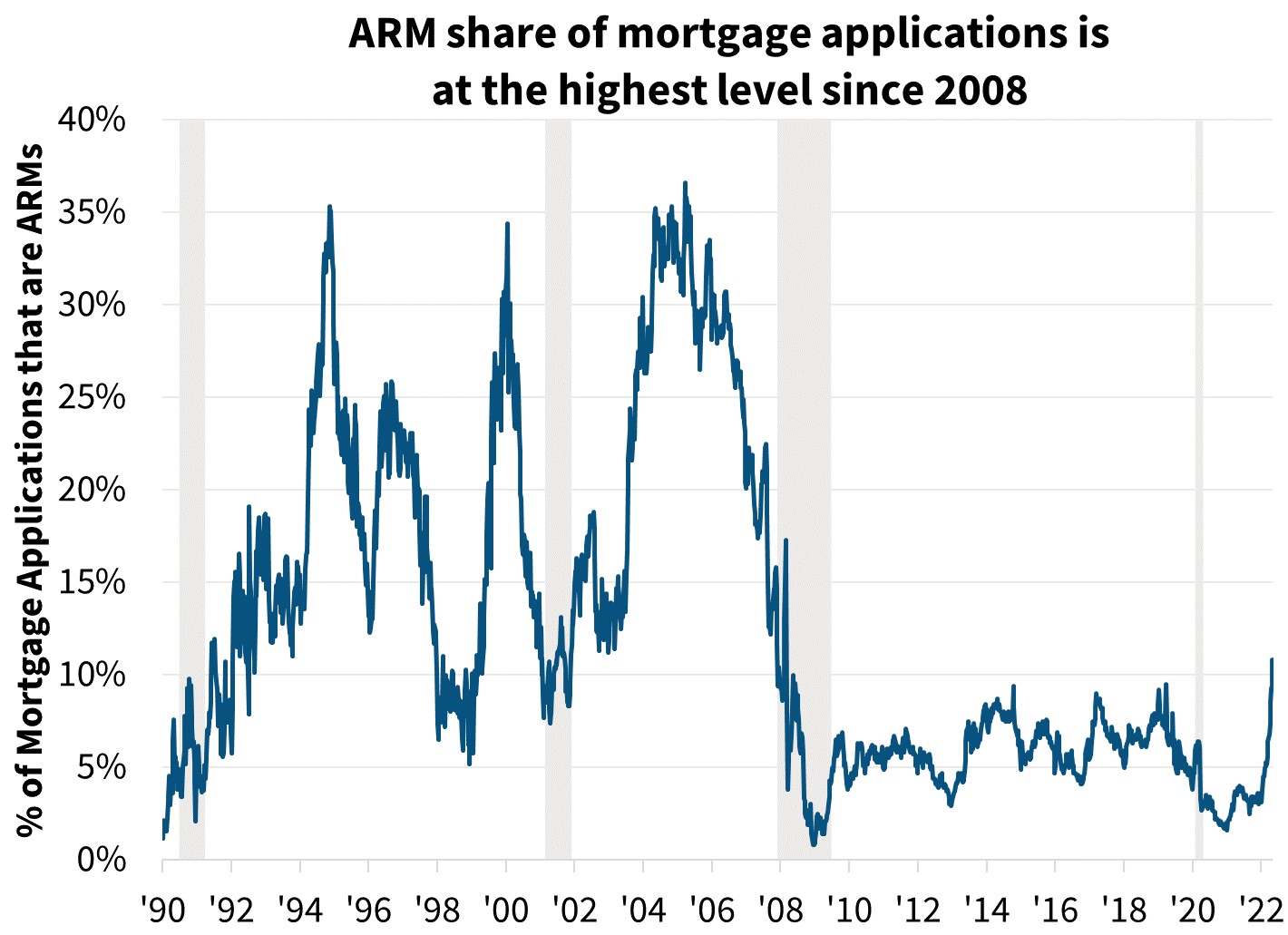Housing Feels Stress of Rising Mortgage Rates as Inflation Weighs on Consumer Spending
We have downgraded both our GDP forecast for this year and our forecasts for home sales and mortgage originations. We now project real GDP growth, measured on a Q4/Q4 basis, to be only 1.3 percent in 2022, down from our previous forecast of 2.1 percent, and to decline in 2023 by 0.1 percent, unchanged from our previous forecast. We revised downward our projection of 2022 and 2023 total home sales by 3.7 percent to 6.1 million and 4.5 percent to 5.4 million, respectively. Total mortgage originations were similarly revised downward, and we now expect 2022 origination activity to total $2.70 trillion and 2023 originations to total $2.25 trillion, down from the respective $2.82 and $2.41 trillion we’d previously projected.
Home sales turned a corner over the first quarter, and we expect a further slowdown over the coming months. Mortgage rates have continued to rise and are now at their highest level since 2009. We forecast a continued slowdown in home sales to be followed by softening construction activity and, lastly, by a large deceleration in house price growth.
First quarter GDP came in weaker than expected, contracting by 1.4 percent annualized. The details of the report, combined with a strong labor market, suggest that a return to growth in the second quarter is likely. However, persistent inflation, which is increasingly eating into consumer spending power, along with rising interest rates and weakening global growth, led us to project only modest growth for the remainder of the year. We are maintaining our call for a recession to occur in the second half of 2023, as we continue to believe that the tightening of monetary policy aimed at curtailing inflation will ultimately tip the economy into a contraction. However, the risks of a recession beginning sooner are growing as inflation remains persistent, financial market conditions tighten, and growth in Europe and China weakens further.
GDP Surprised to Downside in Q1 but Likely Does Not Signal the Start of a Recession
The first quarter GDP contraction was the first since the COVID-19 outbreak in 2020. While the Q1 report was weak, we do not believe this marks the start of a recession. The underlying details point to continued momentum in consumer spending and private investment, which, combined, grew at a strong 3.7 percent annualized pace over the quarter, whereas an imminent downturn would likely show weakness in these areas. The topline was weighed down by business inventory investment and related international trade in goods. These components have been very volatile in recent quarters stemming from changes in global supply chains and oscillating disruptions. Some of the Q1 weakness was “giveback” from an unsustainably strong pace in Q4. Combined with ongoing strong employment growth (428,000 jobs were added in April), we project GDP growth to turn positive again in Q2 2022.
There is risk of a downturn occurring later this year, however. Wage growth has been strong, but inflation continues to be high enough that real income growth is negative on an annual basis. Consumers have increasingly dipped into savings to maintain spending growth, and the savings rate is now below the pre-COVID norm. While there still exists a large stock of dollars in household checking accounts built up over the past two years (about $2.8 trillion above the pre-COVID level) that could support consumer spending, there is a distributional aspect that is not captured by aggregate data. Many households, disproportionately including those at the lower end of the income distribution, likely have little remaining savings to draw down. A surge in credit card balances over the past two months suggests that many consumers are increasingly stressed by the high inflation and are maintaining consumption growth by turning to credit. This trend is unsustainable. Therefore, without some sustained price relief on durable goods, energy, and food in coming quarters such that real income growth can return to positive territory, the possibility of a late-2022 recession becomes more likely.
The April Consumer Price Index (CPI) came in above expectations, but, on a positive note, the report appeared to confirm that price relief for used autos and other durables goods is occurring. Durable goods prices were nearly flat over the month after declining in March. However, services prices continued to accelerate, which we interpret as being in part due to growing pressures stemming from overly tight labor markets. Meanwhile, the recent pullback in energy prices reported in the April CPI release reversed itself in May. Prices for food, which among other drivers have been affected by disruptions related to the Russian invasion of Ukraine, rose 0.9 percent over the month. We expect food price gains to continue to weigh heavily on consumer incomes and sentiment even as durable goods prices stabilize.
Focusing on Job Openings for Guidance on Interest Rates
One key measure to monitor in the coming months will be the ratio of job openings to unemployed persons, which is now at a record high. Growing inflation pressures stemming from labor market tightness need to be cooled if inflation is to return to the Fed’s two-percent target. Chairman Powell has cited job openings as a measure key to the Fed’s assessment of monetary policy. He stated in the May press conference that “there’s a path by which we would be able to have demand moderate in the labor market and [have job] vacancies come down without unemployment going up, because [job] vacancies are at such an extraordinarily high level.” With this framework in mind, we expect the Fed to continue tightening in coming months at 50-basis point increments as long as these labor market metrics do not show signs of excessive weakening. Looking further ahead, however, as discussed in depth in our April commentary, history suggests that underlying wage-price pressures will not be contained unless the unemployment rate rises to something nearer the long-run natural rate of unemployment, most recently estimated by the Congressional Budget Office to be approximately 4.5 percent. At the current unemployment rate of 3.6 percent, an increase of that size has never occurred outside of a general economic contraction. Chairman Powell recently described the task ahead of delivering a “soft landing” as being “quite challenging to accomplish.”
Housing is a Key Mechanism of Monetary Policy
As the Fed tightens monetary policy with the aim of cooling demand in the economy, housing activity is likely to further slow. There are many “channels” through which monetary policy affects the real economy. Several key ones work through the housing market. Home purchases are especially sensitive to interest rates as they directly impact the spending power of a mortgage borrower. Therefore, housing construction, sales, and spending on associated goods and services is a key mechanism through which aggregate demand in the economy is influenced. Changes in residential fixed investment have historically led turns in the economy. Some have even claimed that housing is the business cycle.
Indirectly, slowing house price appreciation also affects consumption growth through “wealth effects” in which consumers are less likely to extract equity from their homes to support additional consumption and, because they feel less wealthy, are more likely to increase their saving rate. Slowing asset price appreciation more generally has been mentioned by multiple current and former Fed officials as being a key to slowing demand to curtail inflation. Former New York Fed President Bill Dudley recently stated, “One way or another, to get inflation under control, the Fed will need to push bond yields high and stock prices lower.”
The Shock to Homebuyer Purchasing Power Has Been Immense
The latest reading for the 30-year fixed rate mortgage according to Freddie Mac was 5.30 percent, up 219 basis points from late December 2021. This is the fastest rate of increase for such a short period of time since 1981. We estimate that the monthly principal and interest payment required to purchase a median-priced home has risen by more than $500 over that time, with the majority of the change occurring since February.
A slowdown in home sales is also not entirely about diminished purchasing power. The rapid rise in mortgage rates creates a large “lock-in” disincentive to purchase a new home on the part of potential move-up buyers. By our estimation, about 85 percent of current outstanding mortgage borrowers have rates at least 100 basis points below the most recent Freddie Mac market survey rate. A household moving even to a similarly priced home would experience a much higher mortgage payment, discouraging such a choice. Our analysis of new listings of homes put on the market shows an 8.4 percent decline in April on a year-over-year basis, down from a 3.8 percent decline in March, suggesting that this disincentive may now be on the minds of many existing homeowners.
Although several measures from real-time housing market data remain indicative of near-term strength, there are some early indications that market activity may be slowing. Redfin reported that 16.1 percent of listings saw price drops over the four weeks ending May 8, up swiftly from 11.7 percent a month earlier and 9.2 percent a year ago. Meanwhile, reports from homebuilders pointing to order cancelations are growing. The April homebuilder’s sentiment survey remained at a high level despite ticking downward, but it also showed a sizable drop in the prospective foot traffic metric. Moreover, in April, the Fannie Mae Home Purchase Sentiment Index® registered a new record low for respondents who believe it’s a good time to buy a home, while expectations that mortgage rates will rise increased.
Home prices relative to median household incomes, even when controlling for mortgage rates, are now more deviated from the historical norm than the peak experienced in 2006. We believe this points to the unsustainability of current house prices relative to longer-run fundamentals, and with rising interest rates this suggests strong downward pressure on continued house price appreciation. Our latest quarterly house price forecast is for annual house price growth to slow from 20.0 percent this past Q1 to 10.8 percent by Q4 2022 and 3.2 percent by end of year 2023, as measured by the Fannie Mae House Price Index. Given the recent rise in mortgage rates and a downward revision to our economic outlook, we see downside risk to our house price forecast for its next update in July. Given the significant variation in regional house price growth, a forecast for 3.2 percent in 2023 implies that some regions will likely experience price declines.
To be clear, even if home prices were to decline in coming years, we are not anticipating a reoccurrence of the housing market or economic turmoil seen during the 2008 financial crisis, as conditions are considerably sounder today. The 2008 crisis was a negative feedback loop of poor mortgage credit quality, foreclosures, and overleveraging of real estate and financial firms that led to a financial crisis and a strong resultant contraction in employment. These factors are not present today. Credit quality is much better, and both the real estate and the financial system are less leveraged. Additionally, mortgage servicers and policy makers are better equipped to manage loan modifications and other workout strategies for potentially distressed borrowers. We also continue to hold the view that there exists an underlying lack of housing supply relative to demographic demand. Vacancy rates remain very low, and speculative overbuilding is not present like it was in many regions in 2008.
Existing Home Sales Continue to Fall – New Construction Comparatively Resilient… For Now
Existing home sales fell in March by 2.7 percent, to 5.8 million units, in line with our forecast. But given higher mortgage rates and a downward revision to our economic outlook, we have also downgraded our existing home sales forecast. We now expect existing sales to decline by 12.4 percent for full-year 2022 (previously an 8.6 percent decline), followed by a further decline in 2023 of 11.5 percent (previously a 9.9 percent decline). New home construction should hold up comparatively well (single-family starts were close to flat in March) in the near term. Homebuilders still face considerable order backlogs, while gross margins reported by many publicly traded homebuilders remain high. This suggests that they have room to offer concessions and discounts to maintain sales volumes going forward. However, given the magnitude of recent mortgage rate increases, we expect new construction to weaken over coming quarters, as well. We downwardly revised our forecast for single-family housing starts in 2022 to 1.10 million (previously 1.13 million). While this represents a decline of 2.6 percent from 2021, it is small relative to the expected decline in existing home sales.
Refinance Originations Coming to a Standstill as ARMs Become More Common
Total mortgage originations are projected to be $2.7 trillion in 2022, a downgrade of $121 billion from last month’s forecast and a decline of 40 percent from 2021. A downward revision to our home sales forecast has resulted in a corresponding revision to our outlook for purchase mortgage originations, which we now expect to total $1.9 trillion in 2022 and $1.8 trillion in 2023, representing downgrades of $29 billion and $95 billion, respectively, compared to last month’s forecast.
With mortgage rates rising, the adjustable-rate mortgage (ARM) share of originations has increased as the spread between a 30-year fixed rate mortgage and 5/1 and 7/1 hybrid ARMs has widened. The ARM share of total mortgage applications, according to the Mortgage Bankers Association, has accelerated in recent weeks, now accounting for 11 percent of applications, but it remains to be seen what percentage of these applications ultimately convert to origination activity. This might help some borrowers manage their monthly payments, though post-2009 underwriting rules require the applicant to be able to afford a payment based on the maximum theoretical rate reset amount. Therefore, unlike the rising rate environments of the pre-2008 business cycles, the use of ARMs will not allow more borrowers to qualify. We therefore expect that the ARM share, while rising, will stay historically modest going forward, especially as the rate spread with fixed-rate mortgages is likely to compress as short-term interest rates rise further due to additional Fed rate hiking.
We now expect refinancing volume to be $797 billion in 2022 and $494 billion in 2023, downgrades of $91 billion and $64 billion, respectively, from the prior month’s forecast. Higher interest rates on mortgages have significantly reduced the incentive to refinance. At the current mortgage rate of 5.3 percent, we estimate that only 1.4 percent of outstanding loans have a refinance incentive of at least 50 basis points. Given the dwindling rate incentive in the current rate environment, we expect refinance origination to decrease by $175 billion in Q2 compared to Q1 and a further $61 billion in Q3. What remains of refinancing activity we expect to be dominated by cash-out refinances. We estimate that cash-out refinances made up 51 percent of the refi market in March and anticipate the share to rise moving forward.
Economic & Strategic Research (ESR) Group
May 12, 2022
For a snapshot of macroeconomic and housing data between the monthly forecasts, please read ESR’s Economic and Housing Weekly Notes.
Data sources for charts: Federal Reserve, Bureau of Labor Statistics, Bureau of Economic Analysis, National Association of REALTORS®, CoreLogic, Mortgage Bankers Association, Freddie Mac, Census Bureau, Fannie Mae ESR Analysis
Opinions, analyses, estimates, forecasts and other views of Fannie Mae's Economic & Strategic Research (ESR) Group included in these materials should not be construed as indicating Fannie Mae's business prospects or expected results, are based on a number of assumptions, and are subject to change without notice. How this information affects Fannie Mae will depend on many factors. Although the ESR group bases its opinions, analyses, estimates, forecasts and other views on information it considers reliable, it does not guarantee that the information provided in these materials is accurate, current or suitable for any particular purpose. Changes in the assumptions or the information underlying these views could produce materially different results. The analyses, opinions, estimates, forecasts and other views published by the ESR group represent the views of that group as of the date indicated and do not necessarily represent the views of Fannie Mae or its management.
ESR Macroeconomic Forecast Team
- Doug Duncan, SVP and Chief Economist
- Mark Palim, VP and Deputy Chief Economist
- Eric Brescia, Economics Manager
- Nick Embrey, Economist
- Nathaniel Drake, Economic Analyst
- Richard Goyette, Economic Analyst
